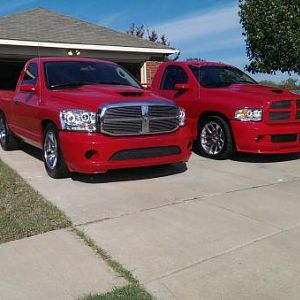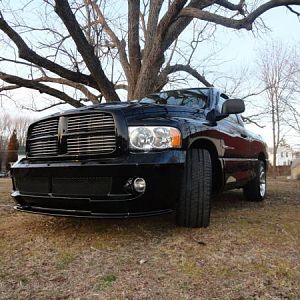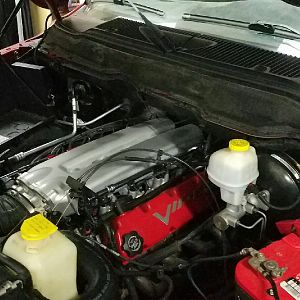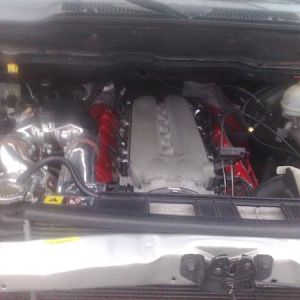ZCx said:
which is best.......
match the heads to the cam
or
match the cam to the heads???
:dontknow: :rock: :burnout:
Match the Cam to the heads, in my opinion. Cams are cheaper too...BUT.. plan BEFORE you buy parts.
No point installing a cam that has .700" lift if the heads quit flowing at .490", for example.
Compression is a big one too. Radical cams that have late closing Intake Valves (long duration) or cams with lots of overlap will bleed off cylinder pressure until the engine speed is high enough to start flowing and building cylinder pressure (torque).
Trying to use radical cams without a corresponding rise in static compression will just cause a loss in torque and make a heavy truck a dog to drive. Cylinder pressure is engine power. A big cam in a low compression engine doesn't work. Plus gas mileage will be brutal.
Refer to info in this older post, if you like:
From a question and answer post Tony Sawyer started...
LIFT: The cam's basic function is to open the valves. Lift refers to how far the valve is opened (or lifted) off its seat. A street performance cam will usually have between .450- and .550-inch lift. More lift can increase power, and increased lift without changing duration increases power without affecting the point of peak power on the rpm band. The rocker arms have a direct effect on lift because they don't have a 1:1 lever ratio. A cam that has .318 inch of lobe lift (that's how far it lifts the lifter) will open the valve .477 inch with 1.5:1 rocker arms (.318 x 1.5 = .477) and .508 inch with 1.6:1 rockers.
Generally, a stock engine will tolerate .500-inch lift before the valves hit the pistons or the valvesprings hit coil bind, but any time lift is increased, these clearances should be checked.
DURATION: Duration is how long the cam holds the valves open. It's expressed in degrees of crankshaft rotation (remember, the cam rotates at half the speed of the crank). A 280-degree-duration cam holds the valves open longer than a 260-degree-duration cam. Holding the valves open longer allows more air and fuel into the engine and also allows more to get out through the exhaust. Longer duration (higher number) improves top-end power but almost always sacrifices low-end torque. Lower duration improves low-end torque and makes the car idle better, but it limits top-end power, and you can get only so much valve lift with a short duration cam due to the rate-of-lift limitations of the lifter. Roller cams, which we'll discuss below, have the advantage of allowing high rates of lift with relatively short duration.
The confusing thing about duration is the difference between "advertised" and "at .050-lift" duration. At .050-lift duration is measured from the point where the cam moves the lifter up .050 inch until .050 inch before the lifter is all the way back down. Most cam manufacturers differ in where they start and finish measuring for advertised duration. Some start at .004-inch lift, some at .008-inch and some measure it somewhere in between. That's why the .050-lift numbers are the best to go by. A 280 cam (advertised duration) from one manufacturer could actually have less at-.050 duration than a 278 cam from another, due to the different points at which the companies measure advertised duration.
LOBE SEPARATION ANGLE: This is the relationship between the centerlines of the intake and exhaust lobes. A 110-degree lobe separation angle means that the peak opening points of the intake and exhaust lobes are 110 degrees apart. This is ground into the cam and can't be changed without changing cams. Lobe separation angle is another way of expressing overlap, which is the term formerly used by cam manufacturers. Overlap is the amount of time that both valves are open in the same cylinder. When both valves are open at the same time, cylinder pressure drops. A cam with 106 degrees of lobe separation angle will have more overlap and a rougher idle than one with 112 degrees, but it'll usually make more midrange power. END JTSVP
Thanks Tony Mahn!!
Provided by RapidRonnie-
... generated from some of the questions..
How much lift should a cam have?-
If the heads hit peak flow, say 300 c.f.m., @.585" lift, you could choose a cam and rocker ratio that provides a total lift of .600" at the valve. Much higher than that punishes the valve train for no real good reason, because the port can't move anymore air/fuel with a higher valve lift than that anyway. Cylinder head flow numbers at values less than maximum lift are also worthy of study. Keep in mind the valve is only at maximum lift for an EXTREMELY short time.
Flow gains in well designed heads (like the NASCAR guys use) concentrate flow improvements in the mid-lift range which will provide usable power over a wider r.p.m. range. I'll put in a plug for Strikers here because they have pretty significant gains in flow in the mid-lift area. So, while peak flow at MAX lift is a guide, it doesn't really tell the whole story.
Compensating for a weak exhaust port with a cam-
Also, you could compare the head's Intake Port with the Exhaust port (a ratio) and have the cam ground to match that. So say the exhaust port flowed 25% less than the intake, you could add more duration to the exhaust side of the cam to help compensate. So you may end up with an Intake Duration Number like 230 degrees @ .050" lift but an Exhaust Duration of 242 degrees @ .050" lift. That would hold the Exhaust valve open longer to help out the poorer flowing exhaust port. You could also increase lift on the Exhaust Side to help out the port as well.
As you may have read before, we won't get much of a power improvement by ONLY changing the cam when using the o.e.m. Viper heads, because the cam & heads are a pretty good match already.
Affects of Overlap-
Increasing overlap (a tighter lobe separation angle, which is lower numerically) will create a peakier power band that tends to kill torque (cylinder pressure) down low and then creates more power (cylinder pressure) once the r.p.m. is high enough to move the column of air THROUGH the engine, in the normal direction.
When an engine is idling and the piston is still rising for the very last part of the Exhaust stroke, during overlap (just when the intake also starts to open) the column of Intake air (and fuel) can be pushed back up into the intake manifold. Then it goes back into the port again towards the cylinder, once the piston descends enough to encourage flow. The boogety-boogety idle sound (gotta love it) is because the airflow from the intake into the cylinder isn't yet stable enough to flow in one direction. So it bounces back and forth until the r.p.m. climbs (somewhere above idle) and inertia helps carry it one way (into the port and cylinder), the chaos diminishes and the engine smooths out. As r.p.m. rises, during w.o.t., engine power (torque) typically climbs until max r.p.m. is reached and somewhere before that point, maximum cylinder pressure, or Peak TQ. is achieved. Side Note:The engine also uses power to push exhaust gasses out of the engine.
Increased Overlap effects vacuum readings as well (they are typically lower) because, when the I & E valves are open at the same time, the engine sees atmospheric pressure. It is camshaft overlap that can make an engine harder to tune, particularly with a supercharged application. If the camshaft "phases" (maximum cylinder pressure) at the SAME time the supercharger has built maximum boost, cylinder pressures can skyrocket. That is prime time for detonation to develop unless measures have been taken (reduce ignition timing, richen the A/F mix, or BOTH) to curtail it.
The reason for overlap is as follows: Somewhere (based on cam design) before the piston reaches the bottom of it's POWER stroke, the exhaust valve opens. As the piston starts to rise again, somewhere before it reaches the top, (again based on cam design), the intake valve opens. This is when overlap is happening, and what overlap is- BOTH valves are open at the same time, in the same cylinder. The more overlap, the longer the intake and exhaust valves are open at the same time. Anyway, the reason for this is because the exhaust gasses are leaving the cylinder and that column of gasses assists (pulls) the column of air and fuel coming INTO the engine through the open intake valve. This is all happening before the actual intake stroke, when the piston descends and the exhaust valve finally closes. One high-overlap trade-off is a lumpy idle (but I like it anyway!) The trick here is to encourage the fresh intake charge into the cylinder without letting too much of it exit through the open exhaust valve.
Side Note- Header primary pipe sizing.
Well designed headers help prevent excess scavenging (when the Air & Fuel that is supposed to stay INSIDE the cylinder to produce power, leaves with the exhaust). This is where header pipe diameter that is too big (even a bit too big) can really screw things up. Something called Rarefaction occurs: This is when a sound wave during the exhaust stroke hits the collector then bounces back UP the primary header pipe towards the cylinder to block and prevent the fresh intake charge from leaving the engine, unburnt. If primary sizing is off, the timing of this event will be as well. But again, this is another topic...
In the end, if you are in the process of choosing a cam- It is always a good idea to check with the company grinding it for you, for their recommendations...
This is quite condensed considering the topic but...
Hope this helps...©
Ronnie






